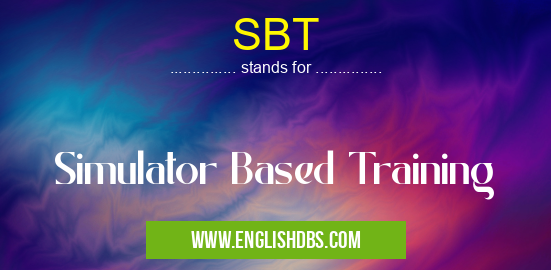What does SBT mean in AIRCRAFT & AVIATION
SBT (Simulator Based Training) is an advanced training technique that utilizes realistic simulations to provide immersive and interactive training experiences. It is widely used across various industries, including aviation, healthcare, military, and engineering, to enhance the skills and knowledge of professionals in a controlled and safe environment.

SBT meaning in Aircraft & Aviation in Miscellaneous
SBT mostly used in an acronym Aircraft & Aviation in Category Miscellaneous that means Simulator Based Training
Shorthand: SBT,
Full Form: Simulator Based Training
For more information of "Simulator Based Training", see the section below.
Key Characteristics of SBT
- Realism: Simulations replicate real-world scenarios and challenges with high levels of accuracy, allowing trainees to experience and respond to situations as if they were in an actual setting.
- Interactivity: Trainees actively engage with the simulation, making decisions and performing actions that influence the outcome of the scenario. This promotes critical thinking and problem-solving skills.
- Safety: Simulations provide a controlled environment where trainees can practice and learn without the risks associated with real-world operations. This allows them to experiment and make mistakes without fear of negative consequences.
- Flexibility: Simulations can be tailored to specific training objectives, levels of experience, and scenarios, making them highly customizable for different training needs.
Benefits of SBT
- Improved Skills and Knowledge: By simulating real-world situations, SBT enhances trainees' understanding and application of concepts and procedures, leading to improved performance in the field.
- Reduced Training Costs: Simulations eliminate the need for expensive equipment, resources, and travel expenses associated with traditional training methods, making SBT a cost-effective solution.
- Increased Safety: SBT minimizes the risks associated with training in hazardous or high-stress environments, allowing trainees to safely practice and prepare for real-world challenges.
- Enhanced Collaboration: Simulations facilitate teamwork and coordination training, enabling trainees to develop effective communication and decision-making skills in collaborative settings.
Essential Questions and Answers on Simulator Based Training in "MISCELLANEOUS»AIRCRAFT"
What is Simulator Based Training (SBT)?
SBT is a training method that utilizes realistic simulators to provide immersive and hands-on experiences for individuals in various industries, such as aviation, healthcare, and military. By using simulators, participants can practice their skills in a safe and controlled environment before performing them in real-life situations.
What are the benefits of SBT?
SBT offers numerous benefits, including:
- Enhanced safety by allowing trainees to practice in a controlled environment
- Reduced training costs compared to traditional methods
- Increased efficiency and productivity due to optimized training time
- Improved skill retention and proficiency through immersive and interactive experiences
- Reduced risks and liabilities associated with practicing in real-life situations
How is SBT used in different industries?
SBT finds applications in various industries, such as:
- Aviation: Simulators are used to train pilots in flight operations, emergency procedures, and aircraft systems.
- Healthcare: Medical simulators are utilized for training in surgical techniques, clinical procedures, and patient care.
- Military: Simulators provide realistic training environments for combat operations, weapon handling, and tactical decision-making.
- Engineering: Engineers use simulators to design and test products, optimize processes, and conduct research.
What are the key features of effective SBT programs?
Effective SBT programs typically include the following features:
- High-fidelity simulators that accurately replicate real-world conditions
- Comprehensive training scenarios and exercises covering a wide range of situations
- Experienced instructors who provide guidance and feedback throughout the training process
- Assessment and evaluation tools to monitor participant progress and identify areas for improvement
- Debriefing sessions to analyze performance, identify lessons learned, and reinforce training objectives
How does SBT compare to traditional training methods?
Compared to traditional training methods, SBT offers several advantages:
- Increased realism and immersion through the use of simulators
- Reduced costs and resources required for training
- Flexibility and scalability to accommodate varying training needs and schedules
- Enhanced safety by eliminating the risks associated with practicing in real-world scenarios
- Improved efficiency and effectiveness through optimized learning outcomes
Final Words: SBT plays a crucial role in modern training by providing realistic and interactive simulations that enhance skills, knowledge, and safety. It offers a cost-effective and flexible alternative to traditional training methods, empowering professionals with the confidence and competence to excel in their respective fields.
SBT also stands for: |
|
| All stands for SBT |
